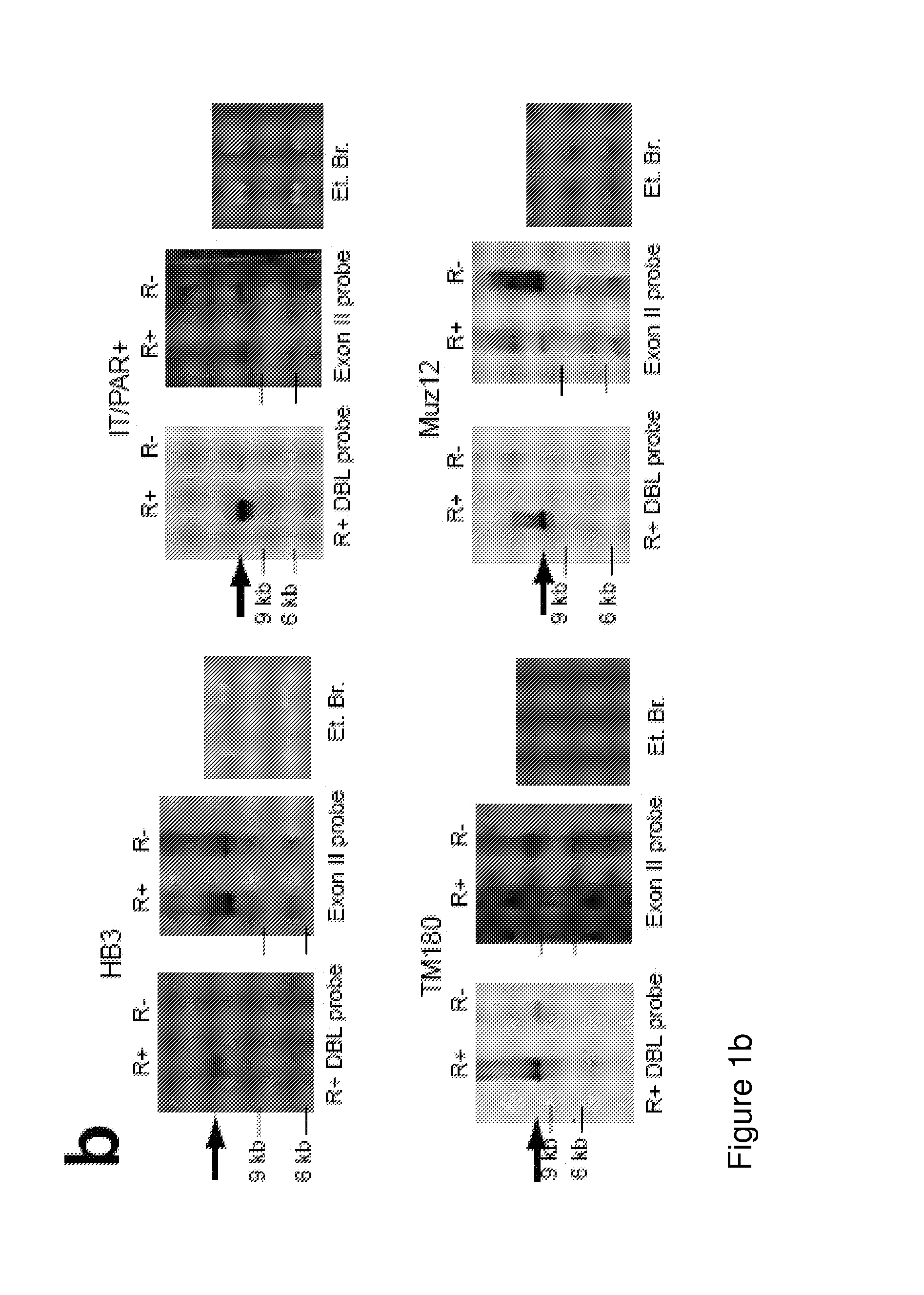Malaria vaccine
a vaccine and malaria technology, applied in the field of antigens, can solve the problems of pfemp1-based drugs or vaccines, the sequence diversity of pathogen antigens is an obstacle to intervention development, and etc., to reduce the burden of parasites, reduce the burden of malaria/severe, and raise the cross-reactive antibody response
- Summary
- Abstract
- Description
- Claims
- Application Information
AI Technical Summary
Benefits of technology
Problems solved by technology
Method used
Image
Examples
example 1
Materials and Methods
Parasites and Parasite Culture.
[0101]The P. falciparum laboratory strains (HB3, Muz12, IT / R29, IT / PAR+, TM180 and TM284) were cultured in supplemented RPMI [59] and selected for rosetting as described [60]. All cultures were checked regularly to exclude mycoplasma contamination [61]. The parasites were genotyped with primers to MSP1, MSP-2 and GLURP [62] and were genetically distinct apart from IT / PAR+ and IT / R29 which share the same genotype but transcribe different PfEMP1 variants. Other parasite strains used were unselected HB3 and 3D7 (CD36-binding), IT / A4 (CD36 and ICAM-1 binding) and three strains selected for binding to human brain endothelial cells (HB3-HBEC, 3D7-HBEC and IT-HBEC, Claessens et al, in press). Clinical isolates were from Cameroon (CAM1), Kenya (KEN7, KEN14, KEN17, 9197, SA075), Mali (MAL27, MAL34, MAL43, MAL81, MAL103) and The Gambia (GAM627). The Malian isolates and KEN7, KEN14 and KEN17 were cryopreserved from previous studies [30,46]. A...
example 2
[0135]The data presented in Example 1 is focussed on antibodies to the N-terminal region (NTS-DBL1a) from the IgM-binding rosetting PfEMP1 variants. The experiments presented in Example 2, investigate whether antibodies to other DBL domains from these PfEMP1 variants would also show cross-reactivity. This would not be predicted from examination of the amino acid similarities between the domains (which are low, mostly between 20-40% amino acid identity).
Materials & Methods
[0136]Recombinant proteins were made in E. coli and antibodies generated in rabbits as described in the main manuscript. Surface reactivity assessed by flow cytometry, rosette inhibition and phagocytosis induction were as described in Example 1.
Results:
[0137]Antibodies were raised to all DBL domains from the ITvar60 variant (FIG. 1A and FIG. 8 below regions shown in red) and also to DBL4ε and DBL5e from the HB3var6 variant (FIG. 1A).
Tests of ITvar60 Antibodies Against the Homologous Parasite Strain (IT / PAR+)
[0138]Th...
example 3
Parasites Expressing ITvar60 are Specifically Recognized by Antibodies in Plasma from Children Recovering from Severe (Cerebral) Malaria
Materials and Methods
Plasma Samples
[0147]Clinical plasma samples from 10 Kenyan cerebral malaria cases and 10 Kenyan non-severe controls (matched by age and date of admission) were collected at acute and convalescent stages. The acute sample (taken on hospital admission) reflects antibodies generated during prior malaria infections (i.e. this is the “baseline” sample); the convalescent sample (taken one month after admission) reflects antibodies generated to the parasites causing the recent clinical infection that resulted in hospitalization of the child.
[0148]Recognition of surface antigens of live P. falciparum infected erythrocytes was tested by flow cytometry. Parasite strains tested were: IT / PAR+ (which are IgM-positive rosetting parasites that express the ITvar60 variant named in the patent), which we predict SHOULD be recognized...
PUM
 Login to View More
Login to View More Abstract
Description
Claims
Application Information
 Login to View More
Login to View More - R&D
- Intellectual Property
- Life Sciences
- Materials
- Tech Scout
- Unparalleled Data Quality
- Higher Quality Content
- 60% Fewer Hallucinations
Browse by: Latest US Patents, China's latest patents, Technical Efficacy Thesaurus, Application Domain, Technology Topic, Popular Technical Reports.
© 2025 PatSnap. All rights reserved.Legal|Privacy policy|Modern Slavery Act Transparency Statement|Sitemap|About US| Contact US: help@patsnap.com



